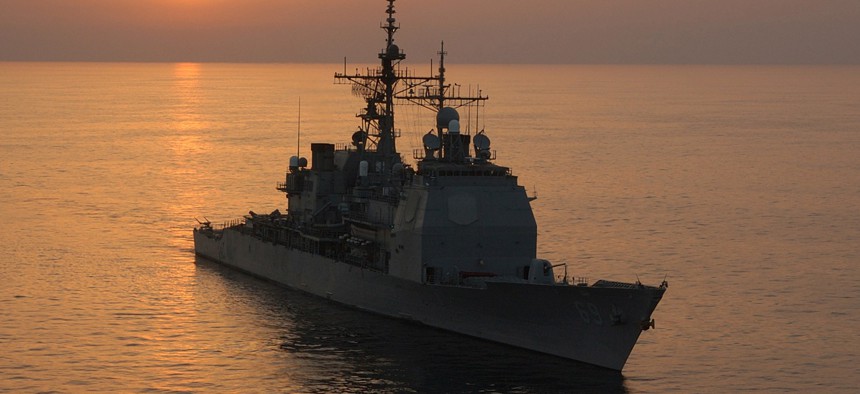
The guided missile cruiser USS Vicksburg (CG 69) sails through the Arabian Gulf during sunset. U.S. Navy Photo
Lawmakers Plan to Save Some of the 24 Ships the US Navy Wants to Cut
House seapower panel has consensus on five ships; full Armed Services Committee will debate others June 22.
Lawmakers are making plans to save five of the 24 ships that the Navy asked to decommission in fiscal 2023, House Armed Services Committee aides told reporters, while the fate of the other 19 will be debated during the panel’s markup this month.
Language has been added to the seapower portion of the House’s nascent 2023 National Defense Authorization Act to prohibit the retirement of five ships: the Ticonderoga-class cruiser Vicksburg and four landing dock ships, a committee aide told reporters on Monday.
“With respect to the seapower mark, what you have here is consensus. There’s consensus that the USS Vicksburg should be retained,” the aide said. “With respect to the LSDs, there’s…strong support for the commandant of the Marine Corps’ assessment that he needs no fewer than 31 amphibious ships, so prohibiting retirement of the LSDs certainly gets after that.”
Members of the House Armed Services Seapower and Projection Forces Subcommittee will finalize their contributions to the defense authorization bill on Wednesday, ahead of the full committee considering the bill later this month.
In March, the Navy submitted its 2023 budget request, which proposed to retire nine Freedom-class littoral combat ships, five Ticonderoga-class cruisers, two Los Angeles-class submarines, four landing dock ships, two oilers, and two expeditionary transfer docks. Sixteen of those 24 ships still have remaining service life.
What to do with the remaining 19 ships will be debated on June 22 at the House Armed Services Committee’s markup of the bill, which can often last for more than 12 hours as contentious issues are debated.
“I can tell you there’s a lot of member interest and that will be addressed in the full committee,” the aide said.
The National Defense Authorization Act is an annual bill that sets the Pentagon’s priorities for the year, but does not appropriate funding. The initial bill is the first step in a lengthy process that includes consideration by the House Armed Services Committee and passage in the House. The Senate will consider its own bill, then reconcile differences with the House, so there are many opportunities for the bill to change.
Lawmakers from both parties have criticized the proposed cuts. Rep. Elaine Luria, D-Va., said in March that “the math doesn’t work” to commission ships early while trying to grow the total size of the fleet. Rep. Rob Wittman, R-Va., the top Republican on the seapower subcommittee, said it’s “grossly irresponsible” to cut working ships as the U.S. Navy shrinks and the Chinese fleet grows.
But others have accepted Navy leaders’ arguments that retiring older ships would free up money to improve the fleet.
“At the end of the day, I want to keep capable ships that we can use against the current and emerging threats we face – not just those that serve to boost our numbers on a spreadsheet. That will be our guiding principle as we move forward,” Rep. Joe Courtney, D-Conn., chair of the seapower subcommittee, said at a hearing in May.
Navy leaders defended the plan to cut ships to Congress just last month, arguing that the $3.6 billion saved over the next five years by axing the ships will go towards other top priorities like boosting readiness or modernizing platforms to ensure the fleet is ready for a high-end fight.
“While building capacity at the expense of readiness and modernization can sound like an attractive proposition, it is not one that I endorse,” Chief of Naval Operations Adm. Michael Gilday told the House Armed Services Committee in May. “We have been there before and we have seen tragic results. I refuse to repeat it again.”
The Navy has 297 ships, but officials have acknowledged the need for a larger fleet. Last year, Gilday said he believes 355 ships is “a really good target,” reiterating a previous goal that has been supported by the service and many members of Congress.
House Armed Services Committee members agreed to save the Vicksburg because a $300 million modernization program to extend the life of the ship is close to completion, a second committee aide said. The ship is also one of the younger cruisers the Pentagon asked to decommission. “That’s the reason Vicksburg was initially targeted” to be spared, the aide said.
The bill would also require the Navy secretary to consult with the Marine Corps commandant on all decisions about amphibious capabilities, and require the Navy to maintain 31 L-Class amphibious ships, the first aide said.




